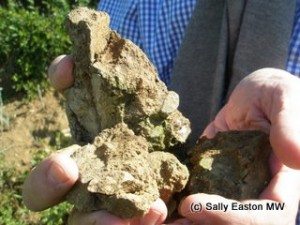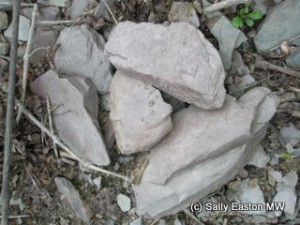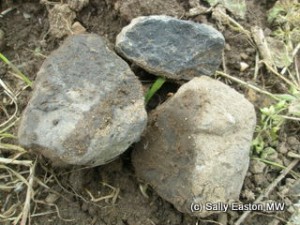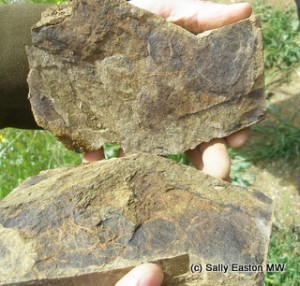Minerality again
A version of this article first appeared in the Drinks Business, February 2010.
Minerality in wine is one of the trendiest tasting terms of our times. Science is establishing that it does exist, at least sensorially, but identifying potential responsible compounds or complex of compounds working in combination, and that can be chemically analysed, remains elusive at best.
No minerality directly from rock
Professor Alex Maltman of the Institute of Geography and Earth Sciences at the University of Wales, Aberystwyth explained: firstly “there is a whole series of complicated ways in which the parent geological minerals decay to yield nutrient minerals”, and “for roots to pick up nutrient minerals, such as potassium and calcium, these elements have to get into solution. Then there is a whole series of complicated ways of those elements getting into the vine roots – a complicated series of distancing reactions between geological minerals and getting nutrients into the vine.

No route from root to wine
“When you start making wine, yeast takes some of those nutrients from the fermenting must, making the connection between mineral nutrients and geological minerals even more remote and complicated.” He added “whatever minerality is, it is not these elements that ultimately came from the vineyard. They’re last in all the things that give wine its flavour.”
With minerals comprising just 0.2% of wine, Maltman said you cannot taste the minerals, especially with all the organic compounds that do give wine its flavour.
Semantic confusion
Though, Maltman explained, “I’m not saying the taste attribute doesn’t exist in wine. But it’s given the label that gives a connotation of origin, of coming from vineyard. People used to talk of austere, lean, steely, even. As soon as people say minerality, people assume minerals are in the wine.“
To geologists minerals are complex compounds – collections of minerals/elements bonded together, such as feldspar. To nutritionists minerals are single elements – zinc, calcium, potassium. To wine people minerality seems to elicit a direct causal link with vineyard rocks despite this being an untenable thesis. All of which creates confusion: of description, of accuracy, of communication. This is not to say that soil, geology, drainage and water holding capacity are not important influences on the flavour of wine.

Mosel slate
Which leads us back to minerality by association: this is Mosel riesling therefore I’m tasting slate’ or ‘this is Sancerre therefore I’m tasting gunflint’. Minerality has relatively quickly become a literal and emotive ‘beam-me-up Scotty’ of rocky allusions which create vinous illusions.
Winemakers’ words
Even winemakers worry for words when trying to explain the ‘minerality’ in their own wines. The ‘reductive’ sulphide connection is often mentioned, as well as other perceptions – a palate texture, tension, tautness, a tingle on the tongue, a cleanness, purity and freshness, an integrative feeling.
Dr. Tony Jordan, of global consultancy Oenotec, said minerality is a “taste sensation. People have talked the talk in the last ten years. It’s one of the buzz words, everything has to have minerality. I tend to associate it with wines that have a finer, tighter, long flavour spine, good spice, that have a distinct play of acid in the balance; occasionally an effect of sulphide, and may even be other chemistry in the wine, both organic and inorganic components.”
This relationship with acidity is a common thread. Martin Aurich, general manager of Weingut Unterortl in Italy’s Alto Adige said: “minerality is a certain amount of acid, acid which is not sour; a positive acid which requires another sip. It’s like a game in your mouth – acid, tannin, sugar.”
Bevan Johnson, managing director of family winery Newton Johnson in South Africa described minerality as “the poise of the finish. It brings a freshness from the mid palate to the finish; a freshness that’s not just acidity. A harmonious finish that’s fresh.”

Pfalz basalt
And Ernie Loosen, of the Mosel’s Dr. Loosen, was emphatic, saying “minerality always has something to do with acidity. Acidity expresses minerality, just as sweetness brings out aroma structure in our wines; as alcohol carries the aroma. A wine without acidity doesn’t show minerality as strongly as wine with the right amount of acidity.”
At Loosen’s JL Wolf estate in the Pfalz, when they taste the wines blind “with its black basalt soil the Pechstein is the most mineral driven. It is more grippy, with a stony edge. The Ungeheuer, with its loamy, weathered sandstone soil, is softer even with the same analytical acidity. Minerality is the acidity and soil together. At the end of the day you can only describe minerality by tasting it.”
Cooler climate
If the acidity thesis gains ground, must minerality be a cooler climate phenomenon? Loosen said he saw less minerality in the hot 2003 than the classic 2007 German vintage.
Climate change specialist Professor Gregory Jones, of the geography department at Southern Oregon University, agreed, saying “grapes grown in cool climates tend to express themselves differently than those grown in warmer climates. Also, cool climate wines are much more likely to be single variety wines than the blends we find in warmer climates. Single variety wines grown at or near their cool climate margin will always show more finesse and character than those grown in warmer climates. A good example is chardonnay, which is grown in cool to fairly warm climates. In a warmer climate there is less finesse and more need for oak to bring out other characteristics. Also a good test is to try the chardonnays grown in the same region in a cool versus a warm vintage … the warm vintage will lack the supposed ‘minerality’ and finesse. So climate does play a role.”

Priorat schist
But what about places such as Priorat, where notes of minerality/graphite are commonly reported in the wines? This is a warm to hot Mediterranean climate where big, alcoholic, blended reds are made. In his inimitable style, Alvaro Palacios of his eponymous Priorat property said “minerality is exactly as you see in the slate or granite soils. There are huge levels of minerals and metals. When you lick them you can feel that. Vegetal tannins are normally very fat, and mild, gentle, soft. Minerality is different; something tiny and vertical that dries out, micro particles.”
Over at Celler de Capçanes, in neighbouring Montsant, winemaker Jürgen Wagner upheld the acidity paradigm, saying “minerality adds some astringency. It gives a feeling of a higher level of acidity. It is a certain saltiness, the graphite of lead pencil for me means nerviness, liveliness, even astringency.”
Scientific speculation
All of which means we are left with supposition and suggestion. Jones suspects “there are chemical pathways via fruit to wine transformation that create aroma/flavour components that spark sensual characteristics that lead us to our cues of certain, remembered qualities.”
Maltman makes it clear he doesn’t know “what minerality is actually due to. I think acidity in wine is relatively well understood so I’m not sure it’s primarily that; my guess would be some combination of organic compounds (secondary metabolites), possibly, as has been suggested, involving sulphur” adding “complex organic molecules could be influencing minerals, promoting some, and buffering others. The effect could be important. I’m saying you cannot taste vineyard minerals. But these tiny amounts could have a chemical role. “
But we are left with more than poetic allegory. Jean Trimbach, of Maison Trimbach in the Alsace, said: “It is there. It exists. It’s the philosophical part of the wine; the most intellectual part of the wine, which has yet to be better analysed, and quantified.”
Wine needs the scientists to get a hurry-on, so we can use the term correctly and consistently as a meaningful communicator of wine quality, composition and style.
Comments
2 Responses to “Minerality again”




March 22, 2012 at 7:04 pm
Sally, thank you for all the careful observation and honest reporting. I find your articles very helpful to my education as an educator! Until there is a definitive, researched protocol for identifying minerality, we must continue to advocate proper implication when using this terminology.
Thanks.
March 23, 2012 at 8:09 am
Thanks for your kind comments Rowan. I do think we need to make sure those we’re speaking to understand what we mean if/when we use mineral / minerality, and possibly explain there appears to yet be a consistent global view, so when others use the term it may mean something different to them. And indeed by explaining something, we tend to use other words, and these may even help to arrive at a more consistent view, even if it’s still anecdotal. Scientists are working on the topic, so it’s only a matter of time.
It’s so much easier for ‘strawberry’ and ‘fresh-cut grass’.